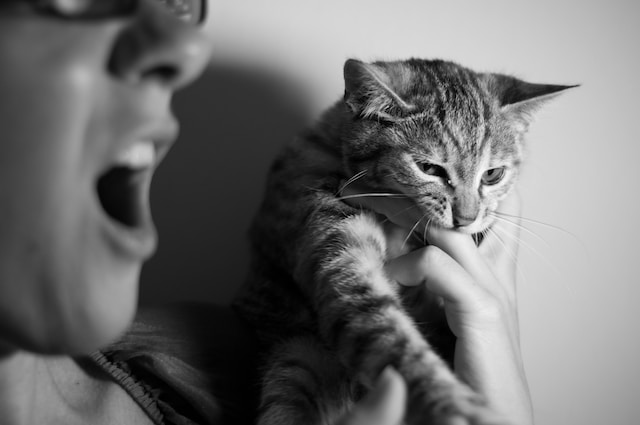I am very clear about my position on squirt bottles: they are terrible tools to try to modify cat behavior. Unfortunately, they’re pretty widely used. Considering I already wrote a whole post on why you shouldn’t use a squirt bottle on your cat, it shouldn’t surprise anyone that I’m not a fan of other methods that cause fear or stress in cats when attempting to modify behavior. It’s especially frustrating when there are more effective, science backed methods to addressing unwanted behavior.
One of the more commonly suggested methods to address cat behavior involves using remote punishments or deterrents. Some of them rely on scaring your cat while others inflict physical pain. Unfortunately, many people wrongly consider them to be a better alternative to a spray bottle because they won’t break your bond with your cat or, in some cases, they are considered humane because they cat is only scared, not physically hurt.
I hope you see the problem with dismissing the cat’s wellbeing as your cat’s emotions matter and a cat being in a not so great emotional state can lead to behavior problems. Thankfully, there are plenty of alternatives so there really isn’t a need to turn to some of these terrible products.
What Types Of Remote Punishment Products Are There?
While I will not be linking to any specific products as I do not recommend any of them, I want to briefly go over what some of the types of remote punishers and what they do.
Startle Based Remote Punishments
The first group of remote punishers are ones that involve startling your cat. The most commonly used ones are ones involving compressed air that is activated when a cat walks by. The idea behind it is that your cat walks by and becomes so startled they never go back. These are often sold as being a humane deterrent because they don’t physically hurt the cat.
Compressed air isn’t the only style of startle based remote punisher out there. There are other types of remote aversive devices that use noise. I’ve also seen people use other types of noise making machines to startle a cat before. And of course there’s the cucumber challenge that went viral a few years back that’s actually really mean to your cat. There are a lot of creative ways people will spook their cats, unfortunately.
Shock Based Products
Another commonly seen set of products used to deter cats from somewhere involves using electric shocks. The manufacturers claim the shocks are mild and people who use these often shock themselves as a way of testing them.
While not as commonly used with cats, shock collars (or the more sanitized name of “remote training collars”) or shock mats are common. Invisible fencing would also fall under the category of remote punishment devices as they rely on shocking an animal when they cross a line (or delivering a warning of some sort that a shock may be coming).
Why Compressed Air Canister Are A Bad Idea
To start looking at the many problems with remote punishment devices, let’s start with the startle based ones. I am going to specifically focus on the motion activated compressed air canisters. These get promoted as being humane and no big deal by certain well know cat behavior folks, but they often gloss over the fallout from them.
First, the entire reason they work (when they work) is based on your cat becoming fearful and stressed. Do you really want to create an environment for your cat where they don’t feel safe and secure in their home? Stress leads to health problems in cats and can contribute to other behavior problems. Plus, the behavior you’re trying to suppress likely is something the cat needs to do anyway and they’re going to need to find another outlet for that urge.
Compressed Air Canisters Are More Distressing Than You’d Think
Believe it or not, I’ve tried the compressed air canisters on myself. No, it was not intentionally. I had a client who had one set up to keep their cat away from a place they didn’t want them going. I walked by it and it sent a puff of air at me. Let me tell you, I full on jumped from how distressing it was.

In order for aversive methods to work, they need to create a certain level of discomfort. If you’re relying on your cat being annoyed by something, if they’re motivated enough to do whatever it is they’re trying to do, they’ll just barrel through the aversive. In other words, you cat needs to be pretty dang scared in order for these to work. Hardly a benign intervention.
They Don’t Always Work
Speaking of cats being motivated enough to ignore the air puff, I see these fail all the time. I’ve had clients with food aggression or feeding related behavior problems who have tried this and their cat just ignores it because food is so motivating. A lot of cats are really smart and will figure out that if they set it off and come back a few moments later, it won’t go off again.
Another problem I’ve heard from clients who have used the motion activated air canisters is that they tend to not work reliably. Sometimes they’ll not go off and other times they’ll randomly go off even when nothing is nearby. That’s a great way to make the environment really scary and unpredictable for your cat. Cats love predictability so the random bursts are going to make something that’s already stressful even worse.
Shock Mats Cause Pain At Low Levels
Shock based devices come with similar stress related problems to compressed air canisters, but with the added layer of risking causing your cat more severe pain or an injury.
While compressed air canisters are marketed as being humane, I still see some very well meaning cat parents try shock mats or even shock collars for a variety of problems. In many cases, the justification is that they tried it on themselves and it wasn’t that bad. While I get the reasoning behind it, there are two problems with this line of thinking.
First, think of how much bigger you are than a cat. Cats’ size is going to make them more sensitive to the shock. It’s similar to how a child may be more sensitive to a medication than an adult would be and why children take smaller doses of medications. Just because you find it to be tolerable doesn’t mean it’s the same for a much smaller creature.
Second, pain is subjective. You may not find something painful, but your cat may find it intolerable. Remember, your cat’s perspective is ultimately what matters. We can’t directly ask them how painful they find it so you may be causing your cat immense pain.
Electric Fences Are Problematic, Too
Electric fences are more commonly associated with dogs, but some people use them to keep their cats in their yard. While some of them claim to be no big deal because the cat gets a warning vibration before they’d get shocked, that warning vibration relies on your cat being shocked initially so they associate it with the pain of the electric shock. You are still causing your cat stress. The benefit they may get from being outside is diminished.

Electric fences don’t keep predators out and your cat could still be at risk of being killed by a coyote, fox, or bird of prey. They also may keep your cat out of the yard if they go past the fence. If your cat is motivated enough to get past the shock, it will stop once they’re far enough away. When they try to reenter your yard, they’ll be shocked. Unless they happen to be so motivated to get through they just push past it, they’ll likely not return home. That’s pretty counter productive.
Shock Devices Don’t Address The Underlying Problem
One of the biggest problems with all remote punishment devices, but especially with shock devices, is that they don’t actually address the underlying problem. Rather, they just suppress the cat’s behavior. The cat still has a need that isn’t being met.
For example, if you use a shock mat to stop your cat from peeing outside the litter box rather than trying to figure out what your cat doesn’t like about the litter box, you’ll be disappointed with the results. In situations where people have tried this, what usually happens is the cat just goes somewhere else. The problem spreads and you have to spend more time cleaning cat pee.
They May Damage Your Relationship
One of the touted benefits of remote punishment devices is that they don’t damage your relationship with your cat like a squirt bottle might as you’re not there activating it. While I’d argue that isn’t enough justification to make them okay as your cat’s wellbeing is important, it’s also not entirely accurate.
If your cat goes on the shock mat with you nearby, they may associate anything that they can see or that is in the area as being the cause of the pain they experience. If you happen to be in the room (for example, if you put a shock mat near a door and your cat gets shocked as you are leaving) when the shock is delivered, your cat may think you caused it. It doesn’t always happen, but it’s a real risk.
That doesn’t mean you should only plug it in when you won’t be home or avoid the area until your cat learns. There are better alternatives to use of these devices.
Alternatives To Remote Punishment
People clearly turn to these devices out of desperation and frustration with unwanted behaviors in their cat. I don’t blame folks for using them, especially as there is a lot of inaccurate information about them from sources that may otherwise be reliable. However, hopefully by now you’ll rethink using remote punishment devices with your cat due to all the risks and fallout from their use.
Thankfully, there are options that are both kind to your cat and don’t carry the same risks. While the solution depends on which unwanted behavior you are trying to address, there are a few things you can try.
- Physically block access to the spaces you don’t want your cat going. This may mean making a bookshelf really full (with a great book on cat body language, maybe?) or not allowing them to have access to certain rooms. For plants, keep your plants in a terrarium or greenhouse. You can also consider using a (cute cat shaped) hanging planter.
- Give them an alternative, acceptable outlet for the behavior. For scratching, a great scratching post is a good start. If they’re climbing your counters, giving them somewhere else to climb works wonders. Often if you do this, you don’t even need to worry about stopping the unwanted manifestation of the behavior as your cat will just go for the acceptable version.
- Remove anything that may may the location appealing. If your cat is getting scraps of food on the counter, wipe it down after use. Remove anything that may pique their curiosity or use museum putty to secure objects to a solid surface so they can’t use it as a toy.
- Create an air lock system. If your cat is door dashing, create a gate system where there are two doors or a tall pen you have to go through in order to leave the home. That prevents your cat from making it outside. Double check they aren’t in the containment area before you go outside and you can make it out without worry.
- Set up a catio or use a tent for outdoor access. This is much safer than free access to the outdoors and allows you to have more control over where your cat goes.
- Make sure your cat isn’t bored. Many unwanted behaviors result from boredom. Your cat should get plenty of play, enrichment, and mental stimulation.
This list is hardly scratching the surface of the things you can do that both allow your cat to be a cat, remain safe, and solve unwanted behaviors. Ultimately, depending on your specific cat, what is motivating them, and what the specific behavior is, you may need to try something different. Focus on what the function of your cat’s behavior is and what you want them to do instead and you’ll find your cat’s behavior improving without the perils of remote punishment devices.










